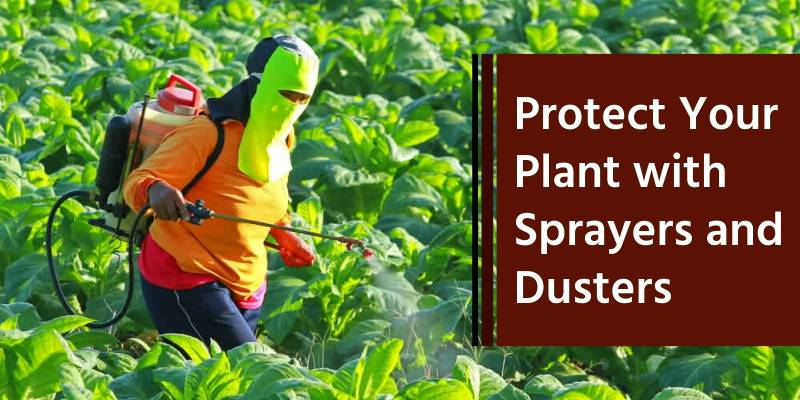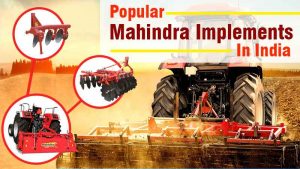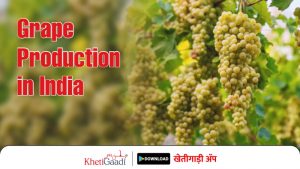Plant Sprayer: As India has a large population in the world, have extra pressure on agricultural land for food required for our large population.
But Most of the time agricultural land becomes infertile due to a lack of micro and macronutrients in soil. The fertilizer industry in India is the need of today’s
issue related to food security.
If we want to feed every Indian, then we must use pesticides and
fungicides to protect our crop from pests and diseases.
Sprayers and Dusters are played important role in the application of fertilizers in the agriculture field, so they called plant protection equipment.
Use of Plant Sprayers
Application of bug sprays to control bugs on plants. Application of fungicides to control plant infections with sprayers.
With the Sprayers application of herbicides to slaughter weeds become easy.
Sprayers used for pre-harvest sprayers to defoliate or condition crops for mechanical gathering.
Application of growth regulators to expand organic product set or forestalls early dropping of organic product. Application of splashes to thin natural product blooms.
Application of plant supplements (showers) straightforwardly to the plant foliage.
Sprayers used for the application of natural materials, for example, infections and microscopic organisms, in showers to control bugs.
The Fundamental Capacity of Plant Sprayers
- To break the fluid into drops of successful size
- To disperse them consistently over the plants
- To standard the measure of fluid to keep away from the unnecessary application
Attractive Nature of Plant Sprayer
The sprayer should create a constant flow of splash materials in the ideal fineness of the molecule so that plants to be dealt with might be covered consistently.
They ought to convey the fluid at adequate pressing factor, so it arrives at all the foliage and spreads altogether over the splashed surface.
It ought to be light yet adequately solid, effectively functional, and repairable
Types of Sprayers
- Boom-type field sprayers
- High-pressure orchard and general-purpose sprayers
- Air-blast sprayers
- Air-craft sprayers
- Granular applicators
- Ground- rig dusters
- Aircraft dusters
- Aerosol generators
Manually Operated Sprayers
- Hand atomizer
- Bucket type
- Knapsack
Basic Components of Plant Sprayer
- Nozzle body
- Pressure regulator
- Nozzle disc
- Swirl plate
- Cut-off value
- Nozzle cap
- Filter
- Spray boom
- Nozzle tip
- Over-flow pipe
- Drop legs
- Spray lance
- Relief- value
- Nozzle boss
- Spray gun
Power Operated Plant Sprayer
Operated for the most part with inner ignition motors. Central player limit shifts from 1 to 5 HP. The pressing factor siphon is worked by a little force unit guaranteeing a consistent pressing factor.
They are worked at a pressing factor of 20 to 55 kg/cm2 and are generally convenient sort. Here and there it is worked by the PTO shaft of the tractor.
The Main Parts of Power Plant Sprayer
- Prime mover
- Tank
- Agitator
- Air Chamber
- Pressure Gauge
- Pressure regulator
- Strainer
- Boom
- Nozzle
Everything About Nozzles
Hydraulic nozzles are utilized for agrarian spraying.
Hollow-con nozzles
The fluid is taken care of into the spin chamber through an extraneous side
section entry or through winding entries in the spin plate or center addition to giving it a rotational speed part.
The hole is situated on the pivot of the spin chamber, fluid arises in a type of empty cone-shaped sheet and afterward separates into drops.
Core-insert is mostly in little-size nozzles and utilized restricted in agricultural splashing.
Solid-cone nozzles
There is the expansion of the inward pivotal hole which strikes the turning
fluid inside the hole of release. The breaking of drops is because of that effect.
Fan-spray nozzle structures tight circular splash design. The fluid is compelled to come out as a level fan formed sheet which is then broken into drops. It is for the most part utilized for low-pressure showering.
Flooding nozzles fluid arising through a round opening encroaches upon a bent diverter which produces a fan-molded sheet having a moderately wide splash point.
The flow pace of a specific nozzle is relative to the square foundation of the pressing factor.
The discharge rate is relative to the opening territory. Nozzles on field sprayers have splash points 600 to 900.
Flooding nozzles have splash points 1000 to 1500 and the working pressing factor underneath 1.5Kg/cm2 is unwanted as the nozzle doesn’t work acceptably.
Low-speed jet break-ups are utilized to acquire uniform, unsurprising drop sizes, and diminishing float.
The pressing factor is low that produces a non-tempestuous stream on account of fluid to rise out of a roundabout opening or narrow cylinder as a barrel-shaped section or fiber.
Components Influencing Droplet Size
Principle liquid properties influencing drop sizes are surface strain and thickness. Expanded surface strain and thickness build drop sizes.
Emulsifiers or water in oil emulsions are utilized for expanding consistency to build drop size. For a given stream rate, pressing factor and shower
point empty cone nozzles have more modest drop sizes than fan splash nozzles. The flooding type produces a coarser splash.
Drop sizes and numbers can be dictated by gathering tests of a splash on glass slides covered with silicone, magnesium oxide, or other comparable material or a gleaming surfaced printing material. Remedy factor is utilized to decide unique circle measurements from noticed stains.
Drop sizes can be estimated by the submersion strategy. The shower drops are trapped in a shallow dish containing fluid or material in which the drop can sink. There, they stay circular.
Cellulose – thickened water arrangement containing cleanser or cleanser can be utilized for oil drop. Measuring and tallying of gathered drops or stains should be possible straightforwardly with a magnifying instrument, or test photo checked with the electronic analyzer. Directly programmed
checking of drops in flight should likewise be possible.
Field estimation of consistency of dissemination made by gathering showered material on mylar sheet or metal plates. The known centralization of the following material is added.
The material from each plate is washed into the determined volume of water. What’s more, the grouping of tracer is estimated.
Nozzle dissemination design is resolved in the lab. By splashing onto a surface that comprises of an arrangement of contiguous, slanting V-box and estimating the fluid gathered from every box. Consistency of inclusion on plant surfaces can be checked by adding fluorescent colors or insoluble fluorescent materials to splash and survey surfaces with glaring light of the dull.
Pumps for Sprayer– Piston or Plunger Pump- Utilized on sprayers with Piston un-clogger, rotary, and diaphragm.
Rotating Pump – Used for low pressing factor sprayers.
Centrifugal Pump– Relies upon outward power.
Miscellaneous Pumps – Diaphragm siphons utilized for stream rates 19 to 23 l/min.
Best Sprayers from KhetiGaadi
- Sprengo 18 Liter Battery Sprayer
- Sprengo Portable Power Sprayer
Plant protection is the most important issue regarding food security. Spraying and dusting help to keep our crops away from pests and disease. Covid -19 pandemic teaches us the importance of sanitation and cleaning.
If you want to keep the doctor away and save your family and crop, then
you should check our sprayer range at KhetiGaadi Mobile Application.
Visit our page for more information about Tractor, Agricultural implements, Tractor Price, Tractor Videos, and Tractor Games.




